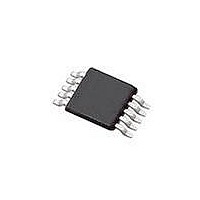SI4010-C2-GT Silicon Laboratories Inc, SI4010-C2-GT Datasheet - Page 91

SI4010-C2-GT
Manufacturer Part Number
SI4010-C2-GT
Description
IC TX 27-960MHZ FSK 3.6V 10MSOP
Manufacturer
Silicon Laboratories Inc
Series
EZRadio®r
Type
Crystalless SoC RF Transmitterr
Datasheet
1.SI4010-C2-GT.pdf
(156 pages)
Specifications of SI4010-C2-GT
Package / Case
10-MSOP
Mfg Application Notes
SI4010 Calculator Spreadsheet AppNote
Frequency
27MHz ~ 960MHz
Applications
Garage Openers, RKE, Security Alarms
Modulation Or Protocol
FSK, OOK
Data Rate - Maximum
100 kBaud
Power - Output
10dBm
Current - Transmitting
19.8mA
Data Interface
PCB, Surface Mount
Antenna Connector
PCB, Surface Mount
Memory Size
4kB RAM
Features
8051 MCU Core, Crystal-less Operation
Voltage - Supply
1.8 V ~ 3.6 V
Operating Temperature
-40°C ~ 85°C
Operating Frequency
27 MHz to 960 MHz
Maximum Operating Temperature
+ 85 C
Mounting Style
SMD/SMT
Operating Supply Voltage
1.8 V to 3.6 V
Supply Current
14.2 mA
Lead Free Status / RoHS Status
Lead free / RoHS Compliant
Lead Free Status / RoHS Status
Lead free / RoHS Compliant, Lead free / RoHS Compliant
Other names
336-1997-5
Available stocks
Company
Part Number
Manufacturer
Quantity
Price
Part Number:
SI4010-C2-GT
Manufacturer:
SILICON LABS/èٹ¯ç§‘
Quantity:
20 000
Company:
Part Number:
SI4010-C2-GTR
Manufacturer:
ST
Quantity:
1 000
Part Number:
SI4010-C2-GTR
Manufacturer:
SILICON LABS/èٹ¯ç§‘
Quantity:
20 000
26. Interrupts
The Si4010 device includes an extended interrupt system supporting a total of 12 interrupt sources with
two priority levels. Each interrupt source has one or more associated interrupt-pending flag(s) located in an
SFR. When a peripheral or external source meets a valid interrupt condition, the associated interrupt-
pending flag is set to logic ‘1’.
If interrupts are enabled for the source, an interrupt request is generated when the interrupt-pending flag is
set. As soon as execution of the current instruction is complete, the CPU generates an LCALL to a prede-
termined address to begin execution of an interrupt service routine (ISR). Each ISR must end with an RETI
instruction, which returns program execution to the next instruction that would have been executed if the
interrupt request had not occurred. If interrupts are not enabled, the interrupt-pending flag is ignored by the
hardware and program execution continues as normal. The interrupt-pending flag is set to logic ‘1’ regard-
less of the interrupt's enable/disable state.
Each interrupt source can be individually enabled or disabled through the use of an associated interrupt
enable bit in the Interrupt Enable and Extended Interrupt Enable SFRs. However, interrupts must first be
globally enabled by setting the EA bit (IE.7) to logic ‘1’ before the individual interrupt enables are recog-
nized.
Setting the EA bit to logic ‘0’ disables all interrupt sources regardless of the individual interrupt-enable set-
tings. Note that interrupts which occur when the EA bit is set to logic ‘0’ will be held in a pending state, and
will not be serviced until the EA bit is set back to logic ‘1’.
Note: Any instruction that clears a bit to disable an interrupt should be immediately followed by an instruc-
tion that has two or more opcode bytes. Using EA (global interrupt enable) as an example:
// in 'C':
; in assembly:
For example, if an interrupt is posted during the execution phase of a "CLR EA" opcode (or any instruction
which clears a bit to disable an interrupt source), and the instruction is followed by a single-cycle instruc-
tion, the interrupt may be taken. However, a read of the enable bit will return a '0' inside the interrupt ser-
vice routine. When the bit-clearing opcode is followed by a multi-cycle instruction, the interrupt will not be
taken.
On this device no interrupt-pending flags are automatically cleared by the hardware when the CPU vectors
to the ISR. The flags must be cleared by software before returning from the ISR. If an interrupt-pending
flag remains set after the CPU completes the return-from-interrupt (RETI) instruction, a new interrupt
request will be generated immediately and the CPU will re-enter the ISR after the completion of the next
instruction.
EA = 0; // clear EA bit.
EA = 0; // this is a dummy instruction with two-byte opcode.
CLR EA ; clear EA bit.
CLR EA ; this is a dummy instruction with two-byte opcode.
Rev. 1.0
Si4010-C2
91












